Surf Zone Steelheading: How To Catch Lake Erie Steelhead from the Shoreline
By: Karl Weixlmann
September 24, 2025
As dark breaks into dawn, a huge cloud bank moving in from the west obliterates a sodden grey sky. The forecast is grim for my first trip of the year with Brian Hall and Evan Morse from Cleveland, but the wind is from the south, keeping the shoreline of Lake Erie relatively calm as small breakers wash over the beach and white foam forms at our feet. The air is electric as the underbelly of the low cloud bank illuminates with interior lightning flashes that transfer to the water’s surface, giving us strobe-like views into the lake's darkness. We see steelhead that are literally swimming right at our feet.
“As dark breaks into dawn, a huge cloud bank moving in from the west obliterates a sodden grey sky. The forecast is grim for my first trip of the year with Brian Hall and Evan Morse from Cleveland, but the wind is from the south, keeping the shoreline of Lake Erie relatively calm as small breakers wash over the beach and white foam forms at our feet. The air is electric as the underbelly of the low cloud bank illuminates with interior lightning flashes that transfer to the water’s surface, giving us strobe-like views into the lake's darkness. We see steelhead that are literally swimming right at our feet.”
(Excerpted from the book, Fly Fishing Guide to Steelhead Alley by Karl Weixlmann)
Table of Contents
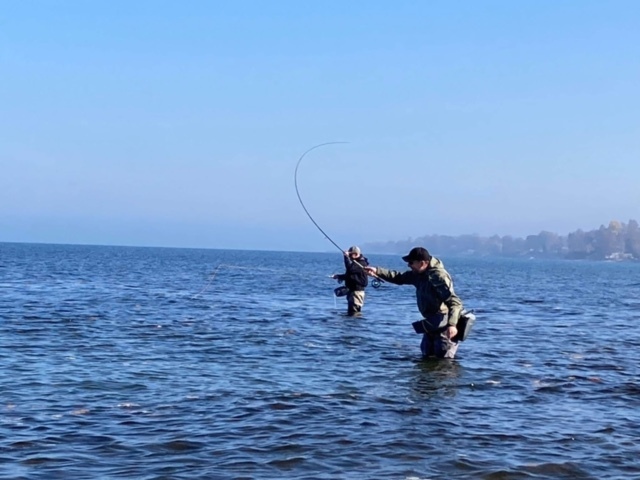
Beach Steelhead: Simply The Best
Fly fishing Great Lakes shorelines can give you an overdose of adrenaline, not only from the environments you can find yourself exposed to but also from the fish themselves. A steelhead hooked off the beach is a different animal, a different beast, one not confined to a tributary pool. If you don't know what color your backing is, you're going to find out rather quickly when a steelhead makes a beeline for Canada in a drag screaming run. Your line is running out to the right but the fish is leaping out of the water 20 yards to the left. It’s simply the best form of a steelhead within its life history that you can hook up on. Pure, unadulterated, chrome.
So how do you find them? Starting points are obviously tributary mouths that flow into the big lakes, but you don't have to be right at the mouth in order to catch them. Induced by the need to spawn, steelhead stage in deeper water near tributary mouths, waiting for optimal conditions before making a migratory run. These early fall fish often give themselves away by leaping or breaching the water's surface near the tributary mouth. Once lake water temperatures drop into the mid sixties, they seemingly sniff around, cruising shorelines looking for acclimation points.
Years ago, there used to be a big boulder on the west side of the mouth of 20 Mile Creek that I liked to get up on and bomb away. I had just moved back to Erie from New England where I had become enamoured with fly fishing for striped bass. I was immediately drawn to the surf zone of Lake Erie, down sized my tackle and fly selection, and started fishing for steelhead on the big water from shore.
It was late September and the fish were there. I kept getting follows with a white, marabou tailed Clouser Minnow but had no takers. After a while, I kept hearing this splashing over my right shoulder and turned around to look. There was an older gentleman standing on the shore and fighting a steelhead with a fly rod.
Back then you never saw a guy with a fly rod on a Lake Erie beach, and we had introduced each other earlier that morning. His name was Ray Bouch. He came up to Lake Erie every early fall from North Carolina. I waded out and watched him land his fish. I mentioned that I was getting some follows but no hookups. He said, “Karl, if you can keep your feet on dry land and you are patient, they will come swimming right in front of you and you can sight cast ahead of them.” It was my first lesson I learned when fly fishing for surf zone steelhead. Thank you Ray, some of it I’ve had to learn on my own, but you were my early mentor.
Reading the Beach
You read the beach shoreline on big water just as you would in a river or stream, and you'll want to scout these areas when the water is relatively calm and the sun is up before fishing them. Steelhead use what I call travel corridors once they enter nearshore waters. Some of these travel corridors are long, running parallel to the beach. Many of the bottom depressions along a Great Lakes shoreline are several feet deeper than the surrounding water and can be large and expansive, holding staging steelhead, sometimes in large, stationary schools.
These depressions and troughs can be deciphered by the color of the water. I look for the darkest, greenest water that can be found near a tributary mouth. Large depressions look like great big bathtubs in the bottom of the lake. Travel corridor troughs can appear as dark ribbons with lighter colored water in front and behind them.
Wind direction can also tell you where to find these fish. It’s probably the biggest decisive factor in which to consider in order to find steelhead positions along the surf zone. Here on the south shore of Lake Erie we first look for south winds to predict finding fishable conditions, though other wind directions should not deter you because they are probably going to change anyway.
One reason why wind direction is so important is because if the tributary has any outflow going into the lake, wind will push that current to the left or right of that mouth. On the south shore of Lake Erie we have prevailing westerly winds which will push that flow to the east of the tributary mouth. An easterly wind will push it to the west. So, a steelhead swimming around and looking for an acclimation point to enter that tributary will usually be found downwind of the mouth. This applies to any Great Lakes surfzone steelhead fishery.
While I’d certainly rather sight-cast to pods of steelhead moving up or down the beach, sometimes rough surf conditions should not deter you from giving it a shot. Rough conditions are normally associated with winds over 15mph, 2 to 3 foot breakers crashing the beach, and low pressure systems that involve precipitation events, which can be just what a steelhead needs to enter a tributary.
I've also seen conditions where the big lake is dirty after a stormy precipitation event, yet the tributaries were still pumping clear water into the lake. One year I waded out in front of 4 Mile Creek and the first pool up from the lake was loaded with people and fish but nobody was on the beach. Lake Erie had a coffee with cream color but I kept following the relatively clear, high on the drop yet slightly stained colored outflow into the gently sloping beach front.
I immediately saw large steelhead cruising back and forth, in and out of dirty water. I put on a large #10 Chartreuse and Flame glow spawn egg pattern under a shallow set float and hooked up some very nice fish. Yes, egg patterns do work off the beach, and if I keep getting follows and refusals from fish that will normally pounce on a streamer an egg under a float can sometimes save the day. My other favorite egg pattern to use off the beach is a simple 3 loop Pink Lady egg pattern that when wet looks just like a glob of eggs.
Before going on to other topics there is one more thing I’ve had to learn the hard way, and maybe even more than once. When fly fishing, never approach the beach near a tributary mouth without being ready to make an immediate cast. Have a fly ready and coils of line stripped from the reel so that when you approach the beach and you see fish, you can catch them, or at least get a shot off. There have been too many times in my life when I wasn't ready. This would most often happen in the middle of a bright sunny day after the beach had cleared of other anglers for lunch.
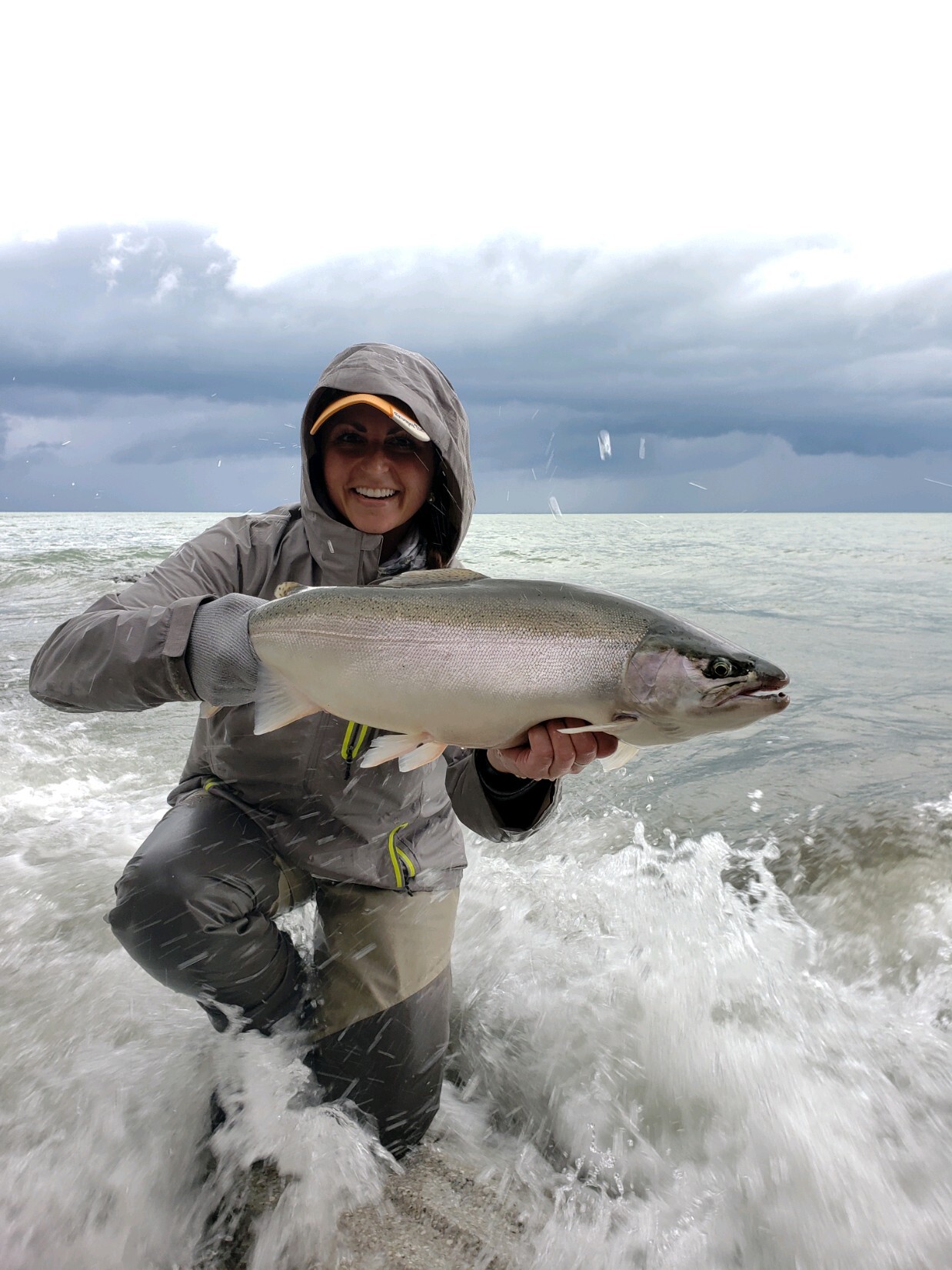
Technique
Streamer fishing is pretty simple, cast it out and strip it back in with an erratic retrieve that imitates an escaping baitfish species. In our neck of the woods that's usually an emerald shiner and if you visually see a bunch of them where you are fishing, match the hatch as they say because that’s probably what the fish are feeding on. You'll want to try different retrieve styles and strips but the one that works best for me are short, sharp strips, not long, gliding strips. Streamers tied with dumbbell eyes give the fly a unique action compared to those that don't. That uh oh, yo- yo action could be just what the fish want.
Speaking of yo-yo action, when I observe the circling behavior of pods of steelhead off the beach, coming in, going out, coming in, going out, I’ll often put a streamer under a float, preferably a Little Precious. It works so well because it can put the fly in front of more fish that
are constantly moving in and out of their travel corridor, plus the wave action as breakers roll in will make the fly yo yo up and down under the float. I prefer a teardrop style float/indicator that gives less resistance to a taking fish. I’ll stagger a couple of Blackbird Shot between the fly and float to get a vertical, 90 degree angle to the fly.
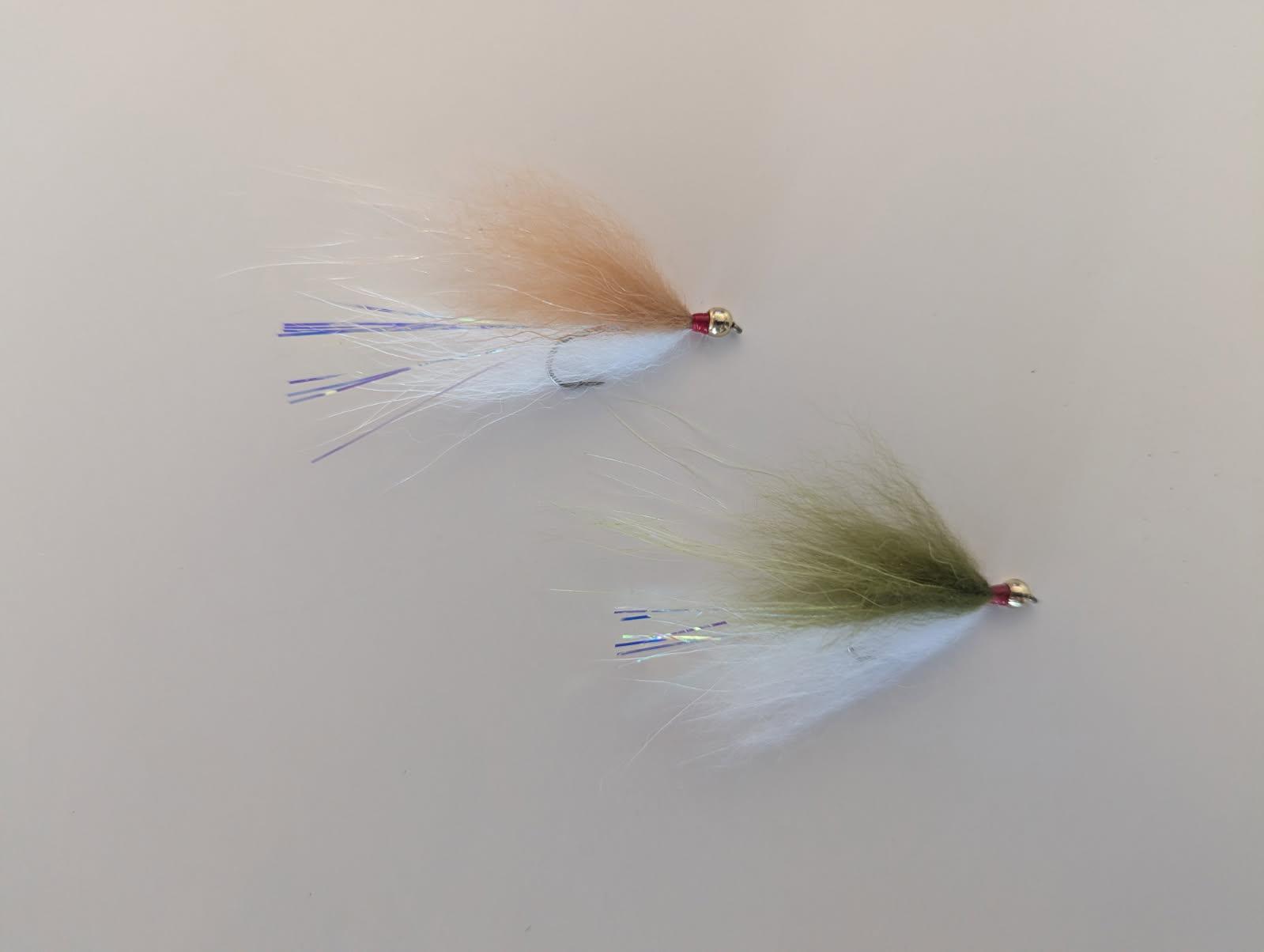
Fly Tackle and Flies
You're not always going to see steelhead swimming right in front of you on a Great Lakes beach and for that reason I prefer a fast action 7 weight fly rod that excels in distance casting. I mean you're competing with the guys throwing spoons, right? If you can’t sight-cast to cruising fish on a particular day, you’ll want to cover water. To be honest, you can catch a lot of fish with a standard weight forward floating fly line, but if you can double haul you'll get more distance with a fly line that has a heavier, thicker head section integrated into a running line like one of the Rio Outbound series. I usually have an extra spool lined with a clear tip intermediate for stripping streamers, though you need a floating line if you switch over to using floats.
Standard 9’ to 12’ tapered leaders ending in a 1x, 2x, or 3x tippet work just fine. Longer and lighter when fishing sunny, calm conditions. A stripping basket really helps when casting in a surf zone environment and helps in getting more distance. If you're not using one while standing in ankle deep water or deeper, waves will tangle the fly line around your legs and the fly line coming out of a stripping basket creates less drag on the line than one coming off of the water below you.
Fly Rods for Lake Erie Steelhead Surf Fishing
More options: Best Steelhead Fly Rods
Fly Reels for Lake Erie Steelhead Surf Fishing
Fly Line for Lake Erie Steelhead Surf Fishing
- For bomb casting and stripping streamers - RIO Specialty Series Elite Predator Fly Line
- For fishing egg patterns or streamers under a float - Cortland 444 Classic Peach Fly Line
Fly Leader for Lake Erie Steelhead Surf Fishing
More options: Best Fly Line and Leader for Steelhead
Materials Needed to Tie the Little Precious
- Daiichi 2220 Streamer Hooks - Size 6, 8 , or 10
- Wapsi Tungsten Slot Beads - ⅛”
- UNI-Thread - Red
- Hareline Dubbin Finn Raccoon Zonker - White and Olive
- Wapsi Flashabou - Pearl
Materials Needed to Tie the Pink Lady Egg
- Daiichi 1510 Glo-Bug Hooks - Size 14
- UNI-Thread - Chartreuse
- Glo-Bugs Yarn - Pink Lady
More options: Best Flies for Steelhead
Steelhead Fishing from the Beach with Spinning Tackle
Although I've been a catch and release, fly fishing only guide for over a quarter of a century, the first surf zone steelhead that I targeted were with spinning tackle back in the early 1980’s. Let's be honest, you can cover so much more water, and do it a lot quicker, and maybe even more effectively, with spinning tackle.
Chucking spoons off the beach is a time honored tradition, one of the best techniques you can use to target cruising and staging steelhead, and you can't go wrong with a classic 1/4 oz. blue and silver Little Cleo. Simplicity in presentation does not go unnoticed by steelhead needing to fatten up before what can be a grueling migration and spawning period. Wobbling spoons create a lot of flash as they are retrieved, enticing steelhead from long distances. To get the best retrieve rate as you reel in a spoon, cast the spoon in front of you before you start fishing and reel it in at different speeds to get a proper consistent wobble that does not spin the spoon.
A countdown method before the retrieve is started can be used in the deeper water found in channels and harbors entering the lake, but off of shallower sloping beaches you may want to start your retrieve right away to avoid snagging bottom and boulders. I can't tell you how many times I’ve watched spinning anglers thrashing rod tips up and down because they've snagged up, losing one spoon after another. Thinner, flatter, wider spoons like Thomas Bouyants can solve that problem because they ride a little higher in the water column than a Little Cleo.
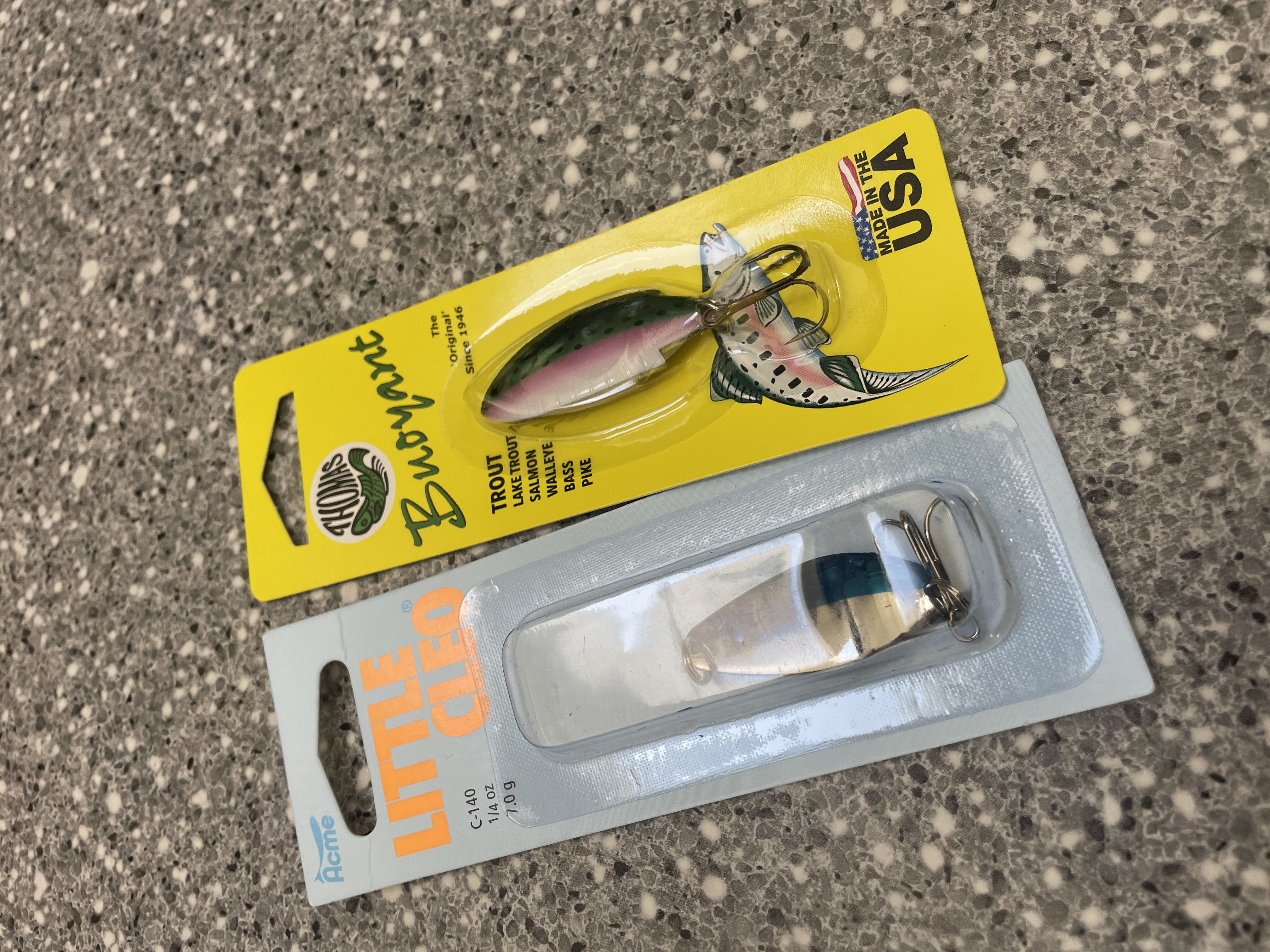
One of our Officers in the early years of the Pennsylvania Steelhead Association organization, the late Tommy Morrison, was fond of casting Flatfish plugs into the Walnut Creek channel leading into Lake Erie and I could see why. I stood next to Tommy many times on the Walnut Wall with a fly rod in hand and watched in amazement as he crushed fish after fish while my streamers would only get follows. Wobbling plugs displace a lot more water than a wobbling spoon, which I think triggers that lateral line predatory response, and not many other plugs can displace as much water on retrieve with such a wide back and forth wobble as a Flatfish.
Flatfish have been around since my grandfather's time and he had many a scarred up selection in his tackle box because he used larger versions for pike and muskie, way before we had viable steelhead fisheries in the Great Lakes. I can't remember ever seeing another angler casting some type of plug from a beach, though I’m sure that close imitations of emerald shiners found in many minnow type plugs could produce a lot of fish.
While jigs, both marabou, bucktail, and feathered have been around for a long time, it’s only in the last decade or so that I’ve seen people using those new, super realistic, baitfish imitation soft plastics. And why not, it’s a presentation a steelhead seldom sees in the surf. I’ll readily admit that I almost always have in my vest, except when swinging big stuff, a fly box filled with marabou or feathered jigs for use when tributary fly fishing. They just plain work too well to discard or disdain, and they work just as well in the surf zone when twitched under a float. As when fly fishing with streamers under a float, stagger a couple of shot between the jig and the float, especially if it's a small and lightly weighted one, to get that 90 degree angle.
Spinning Rod for Steelhead Surf Fishing
- FishUSA Flagship Salmon & Steelhead Spinning Rods - 9’0” Medium
More options: Best Steelhead Rods
Spinning Reel for Steelhead Surf Fishing
- Okuma StormRunner Spinning Reel - 3000 Size
Line for Steelhead Surf Fishing
Lures for Steelhead Surf Fishing
- ACME Tackle Little Cleo Spoon - 1/4oz Silver and Blue
- Thomas Buoyant Spoon - 1/4oz Rainbow Trout
- Worden's Original Flatfish - F6
- VooDoo Custom Tackle Marabou Jigs - 1/64oz, White Pearl-Grey-White
More options: Best Lures for Steelhead
Final Thoughts
I’d personally rather hookup on, sometimes lose and sometimes land, a couple of steelhead from a Great Lakes beach, than a dozen that are stuck in a tributary pool. In the last couple of years our tributary water levels have been drastically low throughout the Great Lakes. This has actually extended my surf zone season through November as I go back and forth from stream to surf.
My fall fishing approach is to hunt and scout the beach first. If we get a major precipitation event that allows steelhead migration up into the tributaries from the lake, I'll probably jump on the one that I know will receive the most fish, for a day, maybe two, because of my observations from the beach.
Early in the season, because of a lack of precipitation during August and September, tributary water levels will drop like a rock in a 24 to 48 hour period. When this occurs, I don't want to have
anything to do with a bunch of anglers plunking lures, baits and flies on top of fish that keep swimming around in circles and have become literally stranded and easily seen. I go right back to the surf zone, because I want to see my backing, again and again and again.
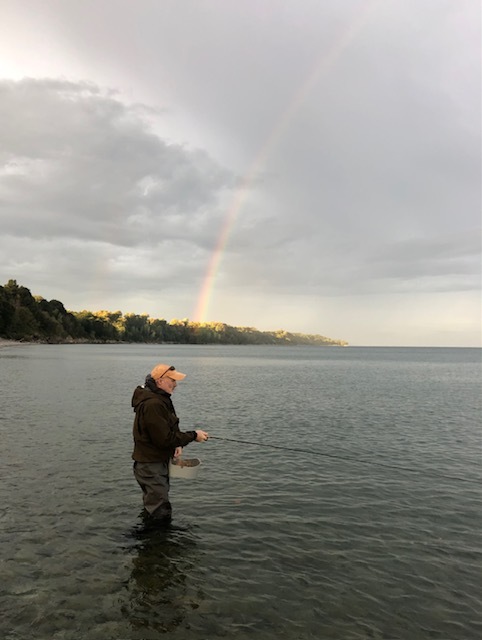
Shop Steelhead Tackle and Gear

